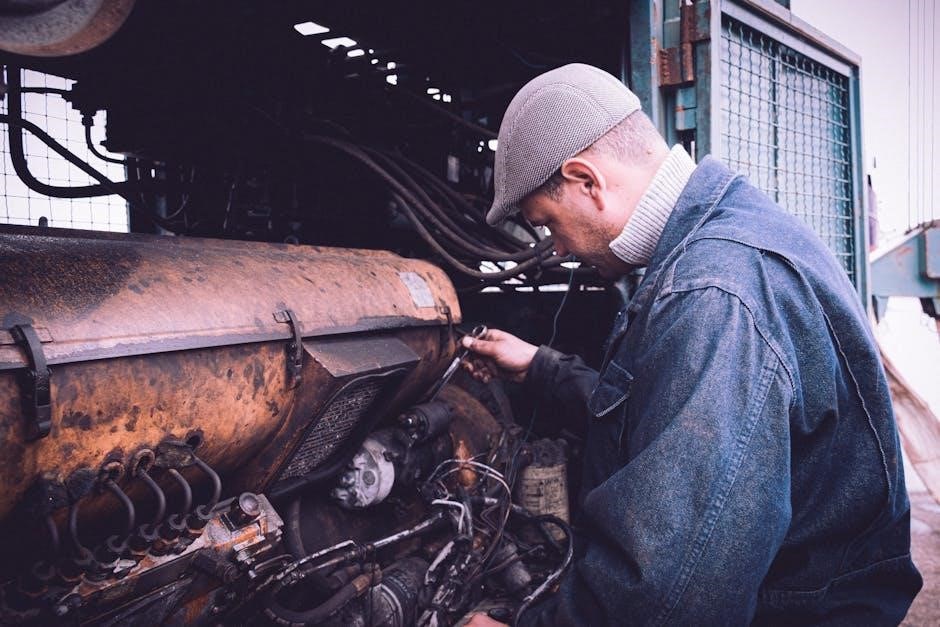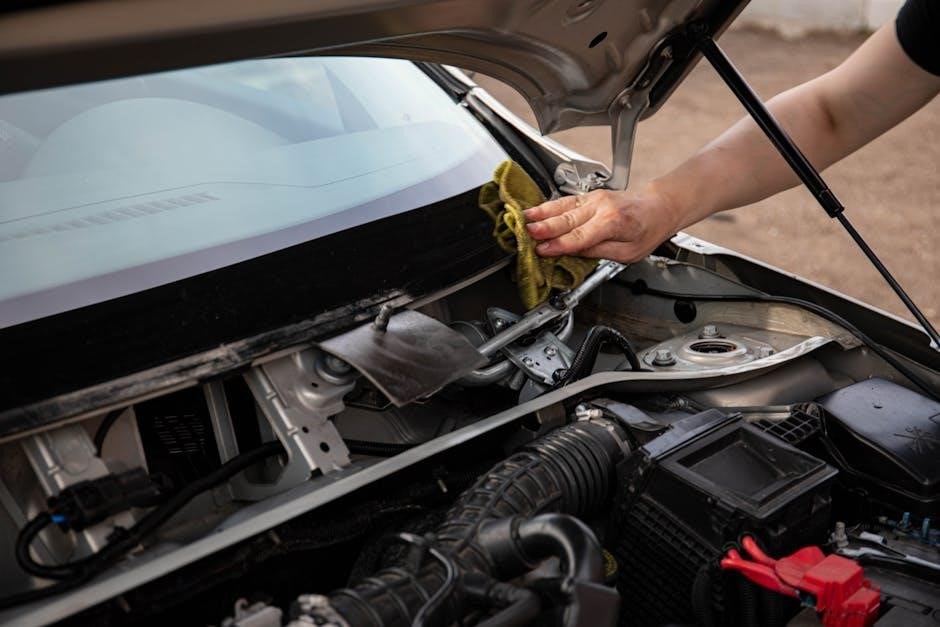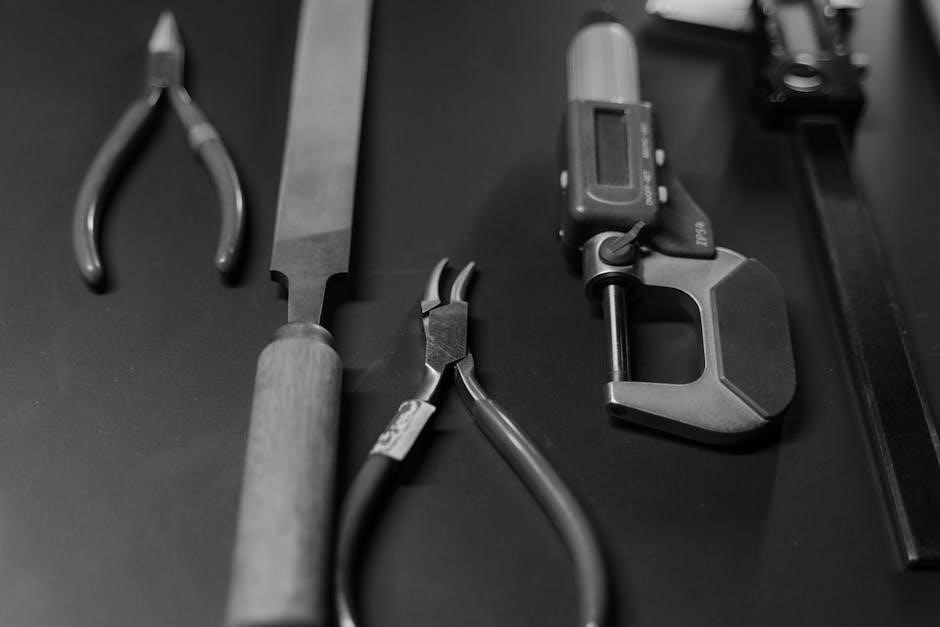Small engine repair is essential for DIYers and professionals alike. A repair manual provides detailed guidance‚ tools‚ and safety tips. Regular maintenance ensures longevity and efficiency.

1.1 Importance of a Repair Manual
A repair manual is crucial for small engine repair‚ providing detailed instructions‚ diagrams‚ and troubleshooting guides. It helps identify components‚ understand repair procedures‚ and ensure safety. Manuals like Briggs & Stratton or Haynes offer step-by-step solutions‚ making DIY repairs efficient. They cover maintenance‚ parts identification‚ and diagnostic techniques‚ empowering users to fix issues confidently. A good manual is indispensable for prolonging engine life and avoiding costly mistakes‚ making it a must-have for both professionals and beginners.
1.2 Basic Tools and Safety Precautions
Essential tools for small engine repair include wrenches‚ screwdrivers‚ pliers‚ and a multimeter. Safety precautions are critical: wear gloves‚ safety glasses‚ and ensure proper ventilation. Always disconnect the spark plug before starting work to prevent accidental starts. Use jack stands for stability and avoid loose clothing that could get caught. Refer to your repair manual for specific safety guidelines. Proper tool usage and adherence to safety protocols minimize risks and ensure effective repairs. Familiarize yourself with these basics before beginning any project.

Understanding Small Engine Components
Small engines consist of key components like cylinders‚ pistons‚ crankshafts‚ and valves. The carburetor mixes fuel and air‚ while the ignition system generates spark for combustion. Understanding these parts is crucial for effective repairs and maintenance.
2.1 Overview of Engine Parts and Functions
A small engine comprises essential parts like cylinders‚ pistons‚ and crankshafts‚ which convert fuel into mechanical energy. The carburetor mixes air and fuel‚ while the ignition system generates sparks for combustion. Additional components include air filters for clean air intake and mufflers to reduce noise. Understanding these parts and their roles is crucial for diagnosing issues and performing repairs effectively‚ as outlined in most repair manuals.
2.2 Identifying Common Engine Models (Briggs & Stratton‚ Honda‚ Tecumseh)
Popular small engine models include Briggs & Stratton‚ known for their durability‚ Honda‚ recognized for reliability‚ and Tecumseh‚ often found in older equipment. Each brand has distinct features‚ such as Briggs’ L-Head design or Honda’s overhead valve technology. Identifying the specific model is crucial for repairs‚ as parts and procedures vary. Manuals typically provide model-specific guidance‚ ensuring accurate diagnostics and maintenance. Familiarizing yourself with these models enhances your ability to service a wide range of small engines effectively.

Essential Maintenance Tasks
Regular maintenance is vital for small engine performance. Tasks include oil changes‚ filter cleaning‚ and spark plug inspections. A well-maintained engine ensures reliability and extends longevity.
3.1 Regular Maintenance Schedule
A well-structured maintenance schedule is crucial for small engines. Tasks should be performed at specific intervals to ensure optimal performance and longevity. Oil changes are typically required every 50 hours of operation‚ while air filters should be cleaned or replaced every 20-30 hours. Spark plugs need inspection and replacement annually or as specified. Regular inspection of belts‚ hoses‚ and mufflers is also essential. Adhering to a schedule prevents breakdowns‚ improves fuel efficiency‚ and extends the engine’s lifespan. Neglecting maintenance can lead to costly repairs and reduced reliability.
3;2 Oil and Filter Changes
Oil and filter changes are vital for maintaining small engine health; Engine oil lubricates moving parts‚ while the filter traps contaminants. Change the oil every 50 hours of use or as recommended. Use the correct viscosity‚ such as 10W-30‚ and ensure it meets the API classification for your engine type. Warm the engine‚ drain the oil into a pan‚ and replace the filter. Dispose of used oil responsibly. Regular oil changes prevent wear‚ corrosion‚ and overheating‚ ensuring optimal performance and extending engine life.
3.3 Spark Plug Replacement
Spark plug replacement is crucial for maintaining engine performance. Over time‚ spark plugs wear out‚ causing poor starting and reduced power. Use a spark plug socket to remove the old plug. Check the gap with a feeler gauge and adjust if necessary. Install the new plug securely but avoid overtightening. For Briggs & Stratton or Honda engines‚ consult the manual for the correct spark plug type. Replace every 100 hours of use or as recommended. A fresh spark plug ensures proper ignition and efficient combustion‚ preventing engine misfires and fouling.

Troubleshooting Common Issues
Troubleshooting small engine problems involves identifying symptoms like poor starting or rough running. Common issues include faulty spark plugs‚ clogged air filters‚ or improper fuel mixtures. Always refer to the repair manual for diagnostic tools and step-by-step solutions.

4.1 Diagnosing Engine Problems
Diagnosing small engine issues begins with consulting the repair manual. Identify symptoms like poor starting‚ rough running‚ or overheating. Check common components such as spark plugs‚ air filters‚ and fuel lines for damage or blockages. Use diagnostic tools like compression testers or spark testers to isolate problems. A systematic approach ensures accurate identification of faults‚ preventing misdiagnosis. Always refer to the manual for specific troubleshooting guides tailored to your engine model.
4.2 Common Faults and Solutions
Common small engine faults include faulty spark plugs‚ clogged air filters‚ and blocked fuel lines. Solutions involve cleaning or replacing these components. A weak spark or improper ignition timing can also cause issues‚ often resolved by adjusting or replacing the ignition coil. Low compression may indicate worn piston rings or cylinder damage‚ requiring professional servicing. Regular maintenance‚ as outlined in the repair manual‚ helps prevent these faults‚ ensuring optimal engine performance and longevity.

Repairing Engine Components
Rebuilding the carburetor and servicing the air filter are common repairs. Replace spark plugs and ignition coils as needed. Addressing worn piston rings or cylinder damage may require specialized tools.
5.1 Rebuilding the Carburetor
Rebuilding a carburetor involves disassembling‚ cleaning‚ and replacing worn or damaged components. Use a repair manual for specific instructions. Start by removing the bowl and float‚ then clean or replace the jets and needles. Inspect the throttle and choke shafts for wear. Replace gaskets and seals to ensure proper airflow. Reassemble carefully‚ ensuring all parts align correctly. Test the engine afterward to confirm proper function. Always refer to the manual for torque specifications and safety precautions.
5.2 Servicing the Air Filter and Muffler
Servicing the air filter and muffler is crucial for optimal engine performance. Inspect the air filter regularly; clean or replace it as needed to ensure proper airflow. For the muffler‚ check for damage‚ rust‚ or blockages. Clean out debris and tighten loose connections. Replace damaged components promptly to maintain noise reduction and emission control. Always follow the repair manual’s guidelines for specific instructions. Proper servicing enhances engine efficiency‚ reduces noise‚ and prevents potential damage from restricted airflow or exhaust blockages.

Fuel and Ignition Systems
Fuel and ignition systems are critical for engine operation. They work together to deliver fuel and spark‚ ensuring proper combustion. Regular maintenance is essential for optimal performance.
6.1 Fuel System Maintenance
Regular fuel system maintenance is crucial for small engines. Clean or replace fuel lines‚ filters‚ and check for blockages. Stabilize fuel to prevent degradation and corrosion. Ensure proper fuel-to-air ratios for efficient combustion. Inspect carburetors and fuel injectors for cleanliness and functionality. Address leaks promptly to avoid performance issues. Follow manufacturer guidelines for recommended fuels and additives. Proper maintenance ensures reliable engine operation‚ prevents costly repairs‚ and extends the lifespan of the fuel system components.
6.2 Ignition System Troubleshooting
Troubleshooting the ignition system involves checking spark plugs‚ wires‚ and the ignition coil. A faulty spark plug may fail to ignite fuel‚ causing misfires. Worn or cracked spark plug wires can disrupt the electrical charge. Test the ignition coil for proper voltage output. Replace components showing wear or damage. Ensure the air-fuel mixture is correct‚ as a rich or lean mixture can affect ignition. Consult the repair manual for specific testing procedures and adjustments to restore reliable engine performance and prevent further issues.
Resources and Further Learning
Consult Haynes and Chilton manuals for comprehensive guides. Online forums and communities offer troubleshooting tips and detailed repair advice. Access manuals like Briggs & Stratton and Honda for specific models.
7.1 Recommended Repair Manuals and Guides
Haynes and Chilton manuals are highly recommended for small engine repair. They provide detailed instructions‚ diagrams‚ and troubleshooting tips. Briggs & Stratton and Honda manuals offer model-specific guidance. These resources cover maintenance‚ diagnostics‚ and complex repairs‚ making them invaluable for both beginners and experienced technicians. Additionally‚ PDF guides like the Small Engines Operation and Service by Jay Webster are excellent for in-depth mechanical understanding. Always refer to manufacturer-approved manuals for accuracy and safety.
7.2 Online Communities and Forums
Online communities and forums are invaluable for small engine repair. Platforms like Small Engine Repair Forums and Reddit’s r/SmallEngines offer practical advice‚ troubleshooting tips‚ and real-world experiences. These spaces connect enthusiasts and professionals‚ providing solutions to common issues. They often include model-specific discussions for engines like Briggs & Stratton‚ Honda‚ and Tecumseh. Active forums also share DIY guides and repair manuals‚ making them a great resource for both beginners and experienced technicians seeking hands-on support and expertise.
